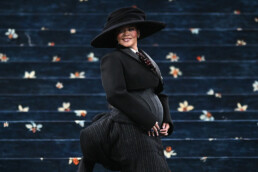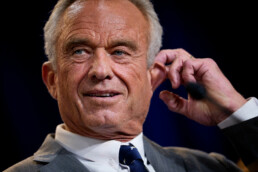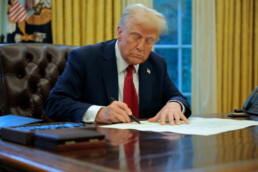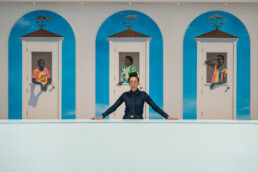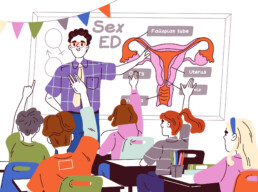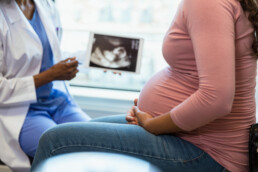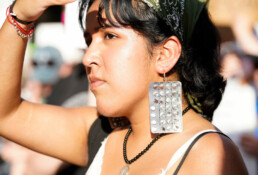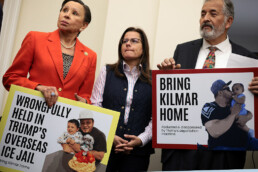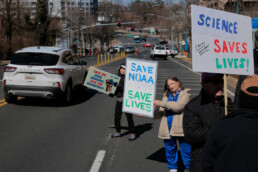A Night of Black Creativity
 May 6, 2025 Hey there, Meteor readers, Hearty congratulations are in order for Meteor collective members Dawn Porter and Tanya Selvaratnam, both of whom are nominated for News and Documentary Emmys this year: Porter for The Sing Sing Chronicles and Documenting Police Use of Force; and Selvaratnam for Love to the Max. Watch if you haven’t! In today’s newsletter, we’re strolling down the blue carpet of last night’s Met Gala with Julianne Escobedo Shepherd—and taking a moment to celebrate midwives. Still thinking about this, Shannon Melero  WHAT'S GOING ON CARDI B AND HALLE BERRY. NO NOTES. (VIA GETTY IMAGES) Fashion’s dandiest night: Whatever your feelings about the Met Gala, this year’s theme, Superfine: Tailoring Black Style, was an important one. It was selected by Costume Institute curator Andrew Bolton last year after he read the 2009 book Slaves to Fashion: Black Dandyism and the Styling of Black Diasporic Identity, by Barnard professor Monica L. Miller, now chair of the college’s Africana Studies Department. Inspired by its deeply researched history of the way formerly enslaved Black people reclaimed the frippery they were forced to wear into their own distinct style, Bolton asked Miller to become the Costume Institute’s first guest curator in his ten-year tenure. The exhibit itself lasts for nearly half a year, long after the last bit of carpet is rolled up. Superfine looks at the lineage of Black style in “the Atlantic diaspora,” and cites Zora Neale Hurston’s “Characteristics of Negro Expression,” an essay from 1934. “The will to adorn is the second most notable characteristic in Negro expression,” Hurston wrote. “Perhaps his idea of ornament does not attempt to meet conventional standards, but it satisfies the soul of its creator.” In other words: Black fashion evolved as a form of resistance against the way white culture expects Black people to be, but it doesn’t matter whether the clothes please anyone but the wearer. Aesthetically speaking, this year contained the best fashion at the Gala in years, its “tailored for you” dress code encouraging attendees to show up and show out as themselves. Co-chair Teyana Taylor wore a long red cape embroidered with the words “Harlem Rose,” created by costume designer Ruth E. Carter, who in 2018 became the first Black woman to win an Oscar for Best Costume Design, for Black Panther. Rihanna donned a deconstructed suit—part jacket, part bustle, part waist-as-lapel—its regal pinstripes channeling the spirit of Ida B. Wells, assuredly strutting into her newspaper job at the New York Age in the 1890s.  DO WE THINK SHE'S HIDING R9 UNDER THAT HAT? (VIA GETTY IMAGES) While the glitter of the Met Gala may seem out of touch in these violent times, it feels significant that Black creativity was celebrated at such a major institutional event, in a moment when institutions are being all but purged of Black people and other people of color. We’ve already seen how the Trump administration’s blatantly white supremacist agenda has affected the Kennedy Center, all cabinet-level departments, and state universities; he has promised to next come for the Smithsonian’s National Museum of African American History and Culture, PBS, and other government-funded institutions that bring alive the history of Black and brown people. Those institutions have only just begun to help this country grapple with its historical atrocities; now, thanks to the administration’s war on what it derisively refers to as “DEI,” the small progress that’s been made is being literally erased. Don’t just talk about it, be about it, goes a common phrase in African American Vernacular English (AAVE). The long national project of what that means politically is being cut off at the knees, thanks to these attacks on Black history in classrooms, libraries, government websites, and museums. So it’s huge that “fashion’s biggest night” at the country’s most renowned art institution was about Black history and Black people reveling in Black fashion as resistance. It was emphasized across every major publication, every tabloid and blog, and all over every social feed—Black fashion history everywhere. As Professor Miller put it to Lala Anthony in an interview on the carpet last night: “I’ve never had such a big classroom.” –Julianne Escobedo Shepherd AND:
  FOLLOW THE METEOR Thank you for reading The Meteor! Got this from a friend?
|
![]()
There's No "Fetus Debris" In Your Vaccine
 May 1, 2025 Howdy Meteor readers, A reminder that as of next Wednesday, you will need a REAL ID for air travel within the U.S. Why am I bothering with this PSA? Because it’s a pain in the ass: I wasted several hours of my own life at the motor vehicle commission, only to be told that the stacks of paperwork I brought were not enough to confirm my identity. Apparently, that’s a pretty common problem, especially for married women, so…best of luck out there. In today’s newsletter, we parse through the most dangerous medical lies of the week. Plus, a long overdue honor is bestowed, and your weekend reading list. Standard ID girlie, Shannon Melero  WHAT'S GOING ONPure malarkey: 👏🏼Stop 👏🏼spreading 👏🏼misinformation 👏🏼about 👏🏼 our 👏🏼health. This week, two major instances of misinformation made the rounds. First up is Secretary of Health and Human Services Robert F. Kennedy, Jr.’s claim that MMR (measles, mumps, and rubella) vaccines contain “aborted fetus debris.” To be clear: These vaccines do not, at all, contain parts of fetuses or fetal cells. What he is referring to is the widely accepted and longstanding use of fetal cells to develop vaccines, which involves introducing a virus or bacterium to human cells and then inactivating or killing the virus. The original fetal cells used to develop the vaccines we now rely on were harvested in the 1960s from two elective abortions. Like all cells, they’ve continued to multiply over the years, and scientists have been using the same line of cells for generations. But as the vaccine education center at the Children’s Hospital of Philadelphia explains, no vaccine injected into a person contains fetal cells. After the vaccine viruses are grown, the manufacturers “purify the vaccine viruses away from the cells.”  So why peddle this falsehood at all? RFK Jr. is a notorious flip-flopper on vaccines. One week, he supports them, the next he doesn't, but no matter what, he casts baseless doubt on their efficacy at every turn—even in the middle of a measles outbreak in Texas. What better way for a vaccine skeptic to dog-whistle conservative-leaning parents than to say there are dead babies floating in the vaccine liquid? (So far, two children have died in Texas as a result of the outbreak, which is two too many.) On to the next big lie of the week. A new “study” titled “The Abortion Pill Harms Women” was released by the conservative think tank Ethics and Public Policy Center, which advertises itself as “working to apply the riches of the Jewish and Christian traditions to contemporary questions of law.” I will not provide the link to the actual study because, as we’ve written before, we should not share links to false or misleading information for any reason. But that didn’t stop Fox News from doing this tomfoolery. Deep breath. Here are the facts: This “study” was not conducted by doctors, whereas the rigorous clinical testing for mifepristone’s FDA approval was conducted by multiple doctors over years. (We spoke to two of them last year.) Instead, it was compiled by data analysts reviewing health insurance claims. What they say they found by reviewing claims’ procedure codes is that nearly 11 percent of women who used mifepristone had at least “one serious adverse event” in the 45 days after taking the pill. But as journalist Jessica Valenti points out, the study does not provide evidence that the “serious adverse events” are directly caused by or even related to the use of mifepristone—they simply happened within 45 days of use. And these “serious adverse events” are loosely defined; for instance, according to Valenti, they include “hemorrhaging,” which could include the heavy bleeding that can be normal after a medication abortion. So why even talk about this “fart” of a study, as Valenti hilariously characterized it? Because it calls on the FDA to “further investigate the harm mifepristone causes to women,” on the grounds that the pill is “considerably more dangerous to women than is represented” on the label. Politicians have already started to parrot that narrative. The new FDA head, meanwhile, is anti-abortion. For the kabillionth time: Abortion pills are safe! AND:
 MAHDAWI AT A CAMPUS PROTEST IN 2023. (VIA GETTY IMAGES)
 LT. COLONEL ADAMS (FRONT LEFT), A MAJOR AT THIS TIME, WITH CAPTAIN MARY KEARNEY BEHIND HER AS THEY INSPECT THE FIRST RECRUITS TO THE 6888 IN 1945. (VIA GETTY IMAGES)  WEEKEND READING 📚On bad buys: Women are still learning about the dangers of multi-level marketing schemes the hard way. (The Cut) On childhood fame: Piper Rockelle, the kid-fluencer at the center of the Netflix documentary Bad Influence, finally breaks her silence. (Rolling Stone) On something you may have missed: This heartwarming, tear-inducing excerpt from Tina Knowles’ memoir, Matriarch. (Vogue)  FOLLOW THE METEOR Thank you for reading The Meteor! Got this from a friend?
|
![]()
The Longest 100 Days Ever
 April 29, 2025 Salutations, Meteor readers, Before we get into it today, exciting news: We’re going to the Tribeca Film Festival! This summer, you can catch the world premiere of Dear Ms.: A Revolution in Print; our very own Cindi Leive served as an executive producer. The film—from McGee Media in partnership with HBO—looks back on Ms. magazine’s 50+-year history to tell the story of how it defied the odds and brought feminism to the masses. Plan to be in New York in June? Grab a ticket! In today’s newsletter, we provide perhaps the only positive take you’ll read about the past 100 days. Plus, Rebecca Carroll talks to Dr. Connie Wun about the 50th anniversary of the end of the war in Vietnam. Counting the days, Shannon Melero  WHAT'S GOING ONThe worst of times: A mere 100 days ago, Donald Trump took office, and it has been a vengeful, embarrassing, and violent presidency thus far. It has also been a test for the American people—so today, we’re heralding the ways women have spent this time fighting back against an overgrown playground bully. Hats off to…
These leaders—and thousands more—are doing the work that needs doing, at one of the hardest times to do it. More of this over the next 1360 days! AND:
 ALL THREE MEMBERS OF SALT-N-PEPA (SANDRA "SALT" DENTON, DJ SPINDERELLA, AND CHERYL "PEPA" JAMES) AT THE 2018 ESSENCE FESTIVAL. (VIA GETTY IMAGES)
 Three Question About...The End of the “U.S. War in Vietnam”Five decades after the conflict’s end, Dr. Connie Wun reflects on generational trauma and the battles we’re still fighting.BY REBECCA CARROLL  THE VIETNAM VETERANS MEMORIAL IN WASHINGTON, D.C. (VIA GETTY IMAGES) Tomorrow marks the 50th anniversary of the end of the Vietnam War—a conflict that remains both controversial and divisive. Here in the U.S., the first televised war brought pushback against the draft, and a feeling that America shouldn’t be intervening in a conflict between North Vietnam and South Vietnam. By the time Soviet-backed North Vietnam invaded Saigon and declared victory in 1975, the protracted war had claimed the lives of as many as 3 million Vietnamese soldiers and civilians, as well as 58,000 American soldiers. Dr. Connie Wun, the executive director of AAPI Women Lead, was raised in Oakland by Vietnamese refugees. We sat down on the 50th anniversary of the exact day that her grandmother and mother were forced to leave Vietnam, to talk about her personal connection to the war, why remembering it matters, and the fight against war on every battleground. In some ways, it feels counterintuitive to commemorate war, but why do you think it’s important to commemorate the Vietnam War in particular? Here [in America] we call it the Vietnam War. In Vietnam, they call it Reunification Day [marking the liberation of southern Vietnam and its reunification with the North after “the U.S. war in Vietnam.”]. And across the globe, it’s called the Fall of Saigon. So, depending upon who you ask, there are various interpretations of what April 30th, 1975, means. Some people are commemorating and honoring the three million-plus people who were killed, and the slow, ensuing deaths that followed. Trauma from the war was among the main causes of my grandmother’s cardiovascular diseases. And that’s the case for many Vietnamese people today. We have high rates of chronic health illnesses, diabetes, and depression, and these are all underreported. My grandmother passed away after having triple bypass surgery. Many of us are permanently displaced and are commemorating the loss of our homeland. I have family members who fought with the Viet Cong, and then people who fought with the South. We are commemorating loss, we are commemorating tragedy. When my grandmother was forced to leave, she left with my grandfather, my mom, aunt, and uncle; my grandmother’s cousins as well as their nieces and nephews. More than 20 people left with them on the flight to the refugee camps in Guam, and then the Philippines. According to our family stories, our family was a part of Operation New Life [a military-led humanitarian effort for refugees who evacuated Vietnam before the end of the war]. Over the past few years, I’ve been collecting our family's stories—I have inherited centuries of warfare. How do you find a definition of solidarity for yourself and the work that you do? The premise of solidarity for me is about surviving, resisting, and ending global and domestic wars. So that’s global and domestic wars against Black peoples, global and domestic wars against Indigenous peoples, global imperialist wars, and colonial wars. Modern civilization is premised upon global and domestic warfare. What I don’t know is if we’ve learned as a whole, and I don't know if we’ve agreed to care about, is that war and its implications are forever. How do we see through to a time when we don’t have wars? We have to undo modern civilization. That’s the task at hand. The way through is to submit to the fact that we’re under warfare. Which is why my grandmother passed away some 20 years after leaving Vietnam. My job, having inherited her legacy, is to keep fighting and to demand that I get to stay alive. I will be one of the people who is going to overthrow what’s taken so many people’s lives. That has to be our commitment to each other—undoing, overthrowing, and building something else.  FOLLOW THE METEOR Thank you for reading The Meteor! Got this from a friend?
|
![]()
The Wonder of Amy Sherald
Ordinary Black life is extraordinary in the artist’s first major mid-career museum survey.
By Rebecca Carroll
Last month, The New Yorker featured a breathtaking portrait on its cover by celebrated Black American artist Amy Sherald. First painted in 2014 and titled “Miss Everything (Unsuppressed Deliverance),” the portrait of a young Black woman wearing a bright red hat is the same piece Sherald later submitted in a competition at the National Portrait Gallery. She won the competition, which caught the attention of former First Lady Michelle Obama, who then personally chose Sherald to paint her portrait for the National Portrait Gallery—making the Georgia native the first Black woman artist to be selected for an official presidential portrait. The Obama painting changed the entire trajectory of Sherald’s career, and since then her figurative grayscale portraits have been shown in public and private collections around the world.
Now, Sherald is having her first major museum survey at The Whitney Museum of American Art, called American Sublime, a title borrowed from the poet Elizabeth Alexander’s book of the same name. I’ve known and admired Sherald for years, and I was thrilled to sit down with her to talk about her work in this truly transcendent exhibition.

Rebecca Carroll: The last time we saw each other in person was pre-Michelle Obama portrait, when we randomly ran into each other on the street in Brooklyn. And here we are today to discuss your first solo exhibition at The Whitney. How are you feeling?
Amy Sherald: I told a friend last week, “I don’t know, I just feel emotional.” And she’s like, “Well, you’re getting used to belonging to the world, and not just to yourself.” Hearing that made me want to cry, and I left her a voice text, and said, “Okay, I’m sitting here holding back tears because I am a thug and I do not like to cry. But that’s exactly what I feel like.”
It’s a lot! The show is also set against a backdrop of political turmoil in America, particularly in regards to race, and actually not dissimilar to what we were experiencing when we last saw each other. At that time, the height of Black Lives Matter, I had written a piece for the LA Times, saying “Even as we see images of what most of us already know, that police violence against Black people in America is occurring with vicious regularity, something remarkable is materializing in its wake. We are also bearing witness to a pronounced moment of Black cultural ascension.” How has your work been impacted by eras of Black cultural ascension versus centuries of Black oppression?
My work was essentially born out of the desire to free myself from a history of oppression, but also in celebration of these eras of enlightenment. What I want the viewer to experience, and I say this in the exhibition [statement], is “the wonder of what it is to be a Black person.” I’m no longer religious, but I speak about this in that language of flesh and spirit—because part of us always has to be activated [in fighting oppression].
Right, exactly. I know you consider yourself as much a storyteller as an artist. As Black storytellers, I feel like we never make anything without parts of each other within us—intergenerationally, ancestrally, futuristically. But when the work goes out into the world and starts to belong to non-Black people, I sometimes feel these waves of protectiveness about it. Do you ever feel that way about your work?
I want the work to belong in the world because it was the only way that I could figure out how to counter whiteness, and the way that everything is saturated with it, comes from it, and evolves around it. My response to that is to make something that’s just as universal, and that can be consumed in the same way, because then [white people] are going to be consuming it in the same way that I had to consume Barbie, and all of these other things.
A pointed example for me was when your portrait of Breonna Taylor was on the cover of Vanity Fair, and it felt so unjust to me that suddenly white people were allowed to look at her in this way that we had seen her all along. Did you feel any conflict about that specific piece?
I didn’t, because of how it started. It started with Ta-Nehisi [Coates], and I trusted him and his vision. Maybe if the call had come from somebody else, then yes, but because it was Ta-Nehisi, no.
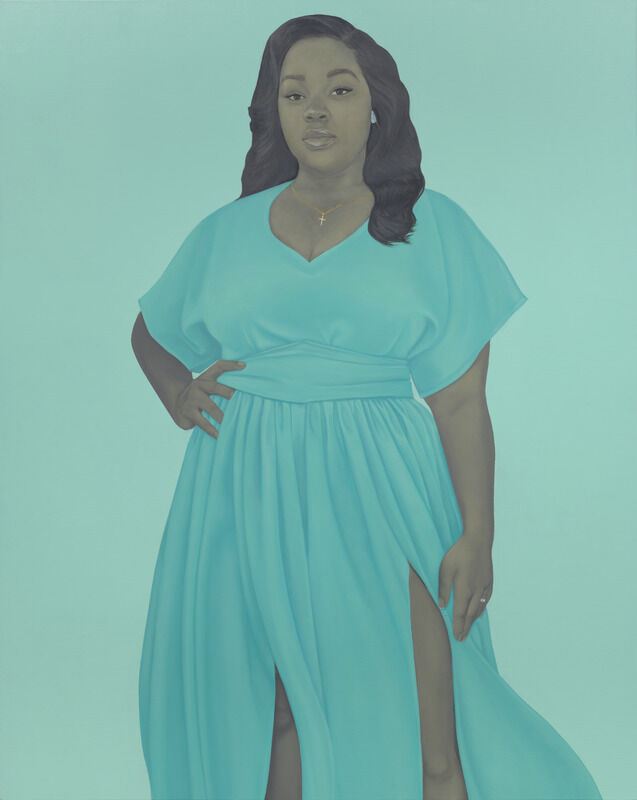
To clarify for our readers, Coates was the guest editor for that particular issue of Vanity Fair, and so that makes a difference, for sure. Now that the portrait is part of this exhibition at The Whitney, what has been the broader response to it?
A lot of people, of all races, are moved to tears by it. After I first finished it, I was really just thinking about how I’ve made this portrait, we’ve photographed it, it’s been on the cover of Vanity Fair, and now it’s in my studio. Now what can it do? I started some conversations, and it ended up being acquired by the National Museum of African American History and Culture. And now there’s a Breonna Taylor Legacy Fellowship and Breonna Taylor Legacy Scholarships for undergraduate students and law school students [at the University of Louisville, in Louisville, Kentucky, where Taylor lived; the fellowships are funded by proceeds from the portrait’s sale]. So if a student is doing anything in regards to social justice, whether their major is political science or art, they have an opportunity to get this scholarship. And then if a student is in law school and wants to work expungement [when a criminal record is erased or made unavailable for public access] cases in Alabama, which pays nothing, then here’s $12,000 to get you through your summer.
Does the idea that Black artists do work for each other resonate with you?
I feel like we make what we make because we are who we are. My mom told me this story about myself, and it stuck with me because I think my work sits in the world in the same way. [When I was a child] sometimes when we had dinner, I would just randomly get up and walk around the table and touch everybody on their shoulder and say, “I love you.” I would go all the way around, and then come sit down and finish my dinner. I think these portraits are “I love yous” out in the world to affirm anybody who is willing to see past the exterior and go deeper into their experience of what it means to be a human.
I love that story. And what do you experience when you look at your work?
I feel like the work sits in The Whitney, and there are words on the wall that explain it, but that work is me—somebody who was once a people pleaser and had a problem saying no, someone who doesn't like conflict or confrontation. My personality made that work.
I would never have looked at your work and thought, “These pieces were made by someone who had a problem saying no.” Are there specific things in the pieces that signal that to you?
I guess that’s where the beauty comes from, because the work doesn’t yell at you. It speaks to you nicely. If you feel uncomfortable in the presence of a Black person, this work will make you think, “Okay, well, maybe I don’t need to grab my purse. I might feel safe in the elevator with this guy.” It speaks to people that way. I went to Catholic school from K through 12, and was always one of two or three Black kids, so I have a lot of patience. I learned a lot of, “Let me explain to you why you can't say that.” Versus my friends that went to all-Black high schools, where it’s just like [gestures taking her earrings off], “Let me tell you…”
But you feel differently now, right? You’re in a different place. How do you think that will affect your work moving forward?
I’m not sure how the work is going to evolve to match who I am now, which is somebody who’s stronger, who doesn't mind saying no, and will look at you while you feel uncomfortable with my answer. I am excited because everything that I’ve made in this show has been living in my head for 20 years.
Does it feel like a kind of excavation in that way?
It feels more like a birth than an excavation. When I think about Black American art history and just our legacy within the larger canon, I feel like we don’t or can’t function on the same timeline as everybody else. It still feels like the beginning of something, this moment of myself, Rashid Johnson, Lorna Simpson, and Jack Whitten [all currently having museum shows]. It feels really great despite everything that’s happening. The art world is representing the world that we want to be—the real world right now.
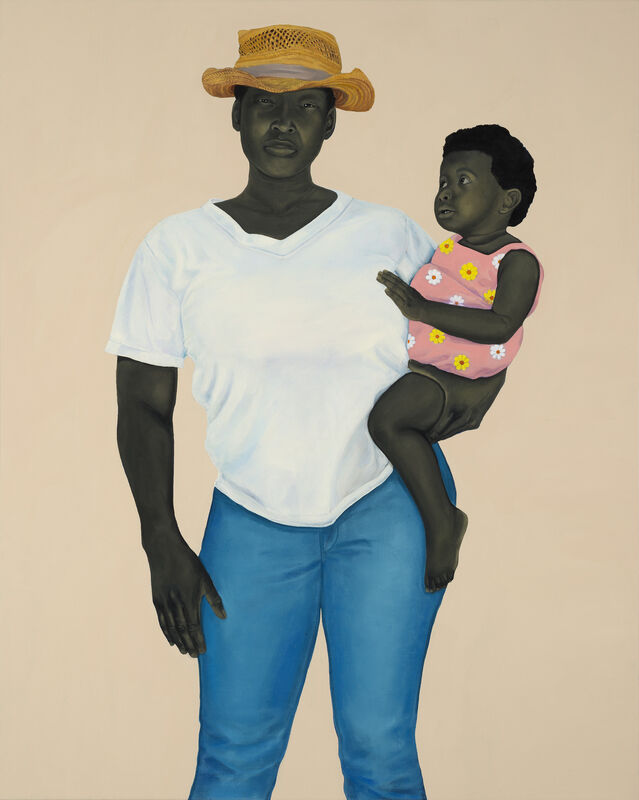
What happens next for you?
I’m hoping that this show will make it into the National Portrait Gallery without having to make any compromises based on who’s sitting in an office at the White House. And I don’t mean, “Well, if I can’t have this painting of two men kissing and a trans person, then I’m not going to do the show.” I feel like that would be a mistake. I feel like it’s a mistake to step down from boards just because [Trump] wants to take over the Kennedy Center. Now more than ever, I feel like it’s important we be in those rooms and not shutting down the conversation. I think the bigger moment would be the work being in the Smithsonian Institution and people coming there to look at American history and Presidents, and then walking into my exhibition.
Whatever the fate of the work in this show, one of the things that really came through as I was walking through the exhibit, just like the way you used to walk around your family’s dinner table and tell everybody you love them—all of these people are taking care of each other, and I felt tapped on the shoulder and loved by every one of them.
Exactly as you should have felt.
Why Is Consent Controversial?
 April 24, 2025 Howdy, Meteor readers, I know everyone is talking about Sinners, but I am what you would call a certified scaredy-cat; I still suffer from Scream. But a bunch of fellow scaredies online say it’s not too bad if you watch it during the day so I’ll see y’all at the afternoon matinee.  In today’s newsletter, we investigate sex miseducation in Indiana. Plus, Nona Willis Aronowitz remembers her “feminist fairy godmother.” Meow, Shannon Melero  WHAT'S GOING ONVirginity education: Yesterday, Indiana’s House and Senate voted in favor of SB 442, titled “Instruction on Human Sexuality.” You might have heard of it (on our Instagram feed and elsewhere) because of a debate over whether that “instruction” should include the idea of consent. The bill’s author, Sen. Gary Byrne (R-IN), had removed a requirement that teachers address consent earlier this week, arguing that the subject could be seen as “controversial.” (Research from the Indiana Department of Health shows that 56 percent of sexually active high schoolers had experienced some form of sexual violence, with 11th grade girls making up most of that group.) After public outcry, though, the consent requirement was re-added to the bill yesterday—your latest reminder that yelling works. But here’s the thing: The bill is still light on the education part of sex education. In addition to consent, it requires sex-ed classes in Indiana to teach four things: abstinence, abstinence (yes it’s listed twice), instruction that the best way to avoid STIs is a “mutually faithful monogamous relationship in the context of marriage” (we remind you, these are children and teens), and the viewing of a high-definition ultrasound video, at least three minutes long, depicting the development of organs in a fetus. It’s giving Catholic-school health class, and I would know, as someone whose sex-ed was having to watch the movie Riding in Cars with Boys. Let’s linger on the video for a second. These kinds of videos—most notably the notorious “Baby Olivia”—have cropped up over the last two years as a tool of the anti-abortion movement and are more often than not, medically inaccurate and meant to elicit an emotional response rather than be strictly educational. When pressed about the video requirements by Democratic senators yesterday, Byrne insisted he was not specifically suggesting “Baby Olivia,” IndyStar reported, and that school boards would be able to choose which films get shown to students. “There’s plenty of examples of videos,” he argued. (When pressed to name them, he could not.) Indiana is, of course, not the first state to introduce such narrow requirements for sex-ed classes or to inject what sound like conservative Christian views of sex into a secular public school system. Currently, 37 states have laws that require abstinence as part of sex education, while only 18 require teachers to share information about birth control. As far as education around consent? Only 12 states—13 if the Indiana bill passes—require that it be mentioned. But studies show that simply telling teenagers not to have sex doesn’t protect them from STIs or unwanted pregnancies. What does work, according to the Sexuality Information and Education Council of the United States, is comprehensive education that includes consent, contraception, STI prevention, and sexual health for LGBTQ+ communities. AND:
 OBAMA AT A LIVE TAPING FOR HER PODCAST, "IMO." IN HER LEFT HAND, SHE CAN BE SEEN HOLDING ALL OF HER DESIRE TO CONTINUE BEING A PEOPLE PLEASER. (VIA GETTY IMAGES)
 DURBIN IN 1994. (VIA GETTY IMAGES)  WEEKEND READING 📚Online: When we said we wanted a “womanosphere” this is not what we meant. (The Guardian) On history repeating itself: Historian Greg Grandin explores Latin America’s journey from “fighting to facilitating fascism.” (Democracy Now) On mixtapes: Have a cry with writer Jill Mapes, her dad, and a shared appreciation for good music. (Hearing Things)  FOLLOW THE METEOR Thank you for reading The Meteor! Got this from a friend?
|
![]()
You Can't Pay Us to Have More Kids
 April 22, 2025 Greetings, Meteor readers, It’s Earth Day! And also, it’s Taurus season! May we all feel some stabilizing, comforting energy over the next few weeks because boy, do we need it. In today’s newsletter, Nona Willis Aronowitz explains what’s behind the administration’s “make more babies” plan. Plus, we bid farewell to the pope. Bulls up, Shannon Melero  WHAT'S GOING ONBaby bust: Yesterday, the New York Times reported that the pro-natalist Trump administration, concerned about the U.S.’s falling birth rate, has been brainstorming ways to get American women to have more children. Some of their ideas include five-thousand-dollar baby bonuses, menstrual-cycle education, and a National Medal of Motherhood (a tactic you might recognize from the Nazis). Notably missing: plans to subsidize childcare, parental leave, or any other crucial improvements actual families have been requesting for generations. Lots of incredulous reactions across the internet made that exact point: “How can you expect us to have more babies without a strong social safety net?” As someone who yearns for free daycare and paid maternity leave, I’m tempted to say the same. Yes, it’s darkly ironic that the Trump administration is calling for more babies even as it has made deep cuts to maternal and child health and opposed any repair of the U.S.’s woefully inadequate family policies. But the thing is, offering benefits to families doesn’t actually boost birth rates. In fact, many countries that provide robust support for parents, like Finland, Norway, and Germany, have birth rates below ours. There’s no evidence that Trump’s proposed policies would work, either. “Even the richest, savviest, most committed governments” are stumped, a history professor told Vox in 2023. “If such policies were discoverable, I think someone would have discovered them.” So the question you’re probably wondering is: What’s so bad about the birth rate falling? Most countries in the world are now below the “replacement rate” of 2.1, and the trend is most pronounced in the richest nations; the United States is at about 1.6, a drop of more than 20 percent in the last decade. Seen one way, fewer babies is a success story of women truly having control over their own lives, and—thanks to contraception access, education, and career opportunities—being able to make choices that may or may not involve children. Maybe those decisions “shouldn’t scare us,” writes feminist writer Jill Filipovic, “but should inform us that when women have more options and opportunities, women’s desires become far more varied.” Still, experts across the political spectrum agree that a shrinking population with more old people than young presents huge economic and humanitarian challenges. An aging society means fewer workers to keep society functioning—to grow our food, to build our houses, to care for the elderly. For many, the story of South Korea, which has the lowest birth rate in the world, provides a disconcerting glimpse of what happens when so few babies are born: 1 in 5 people in South Korea are over 65, and nearly 40 percent of those elders live in poverty. But no matter how valid these concerns are, Trump’s “solutions” are both demeaning (ugh, that medal) and historically familiar: The one way governments have temporarily bumped up birth rates throughout history is by oppressing women. Think Nazi Germany and its Lebensborn program, which used women as incubators for 20,000 “Aryan” babies. Or Ceausescu's Romania, which severely restricted abortion and birth control access to devastating effect. Even our own “baby boom” in the repressive 1950s partially relied on pushing women into domesticity. This brand of pro-natalism—promoted by people like J.D. Vance, Tucker Carlson, and Elon Musk—often goes hand-in-hand with racism and anti-immigrant sentiment. While immigration is often touted as a short-term solution to the U.S.’s low birth rate, the Trump administration’s cocktail of natalism and xenophobia makes clear that they don’t want more babies of all kinds, just white, Christian babies in heterosexual nuclear families. So, yes, I agree that we should seriously grapple with how to reshape society in the face of population decline. I just don’t trust this administration—with its blatant disregard for families and basic human decency—to do it. —Nona Willis Aronowitz AND:
 POPE FRANCIS DELIVERED HIS FINAL EASTER SERMON AT THE VATICAN THE DAY BEFORE HE DIED. VIA GETTY IMAGES
 COLUMBIA STUDENTS AND ALUMNI CHAINED THEMSELVES TO THE UNIVERSITY'S MAIN GATE LAST WEEK TO PROTEST THE DETENTION OF STUDENTS. (VIA GETTY IMAGES)
 FOLLOW THE METEOR Thank you for reading The Meteor! Got this from a friend?
|
![]()
The New Binge Drinkers
 April 17, 2025 Dearest Meteor readers, I’m feeling tender this week and I’m gonna blame Dying For Sex, the new FX miniseries about actual death, the little death, and ride-or-die friendship. The final episode had me in a puddle the other day. Highly rec’d if you’re a fan of Michelle Williams and/or catharsis.  Today, we dig into a surprising new statistic about young women and drinking. Plus, affirmative action for white men and justice for Black mothers. Still sniffling, Nona Willis Aronowitz  WHAT'S GOING ONA sobering new study: If your image of a young binge-drinker is a frat boy doing keg stands, you’re out of date, according to a new analysis in the Journal of the American Medical Association. While drinking among young people is declining overall and older women still drink less than older men, women ages 18 to 25 now binge-drink slightly more than their male counterparts. (Binge-drinking is defined as regularly having more than four drinks in one sitting for women and more than five drinks for men; the study compared data from the National Survey on Drug Use and Health between 2017-2019 and 2021-2023.) Women’s drinking habits have been catching up to men’s for decades, and scholars, journalists, and public health advocates have been noting the results: Women are increasingly dying, getting sick, and going to the ER from drinking. And why are we drinking more? It’s partly because of stress. (Research indeed shows that women are more likely to drink in order to cope than men. See also: “Mommy wine culture.”) The pandemic seems to have compounded the problem; articles and studies have abounded since 2020 showing how much more women were drinking to get through their days. Women, some have concluded, “need an intervention.” (Others, as one Meteor commenter put it a few months back, are “tired of being targeted for all the things.”) But what accounts for younger women binge-drinking more than younger men? The study was careful not to draw conclusions; the authors say that because the groups analyzed in each time period are not the same people, they don’t know whether we’re seeing an actual rise among young women or, perhaps, a decline among men. But Susan Stewart, a professor of sociology at Iowa State University who studies alcohol use among women, has an initial hypothesis: “I think it has to do with women’s independence,” she says. “Young people are dating and having sex at lower rates, and less interested in serious relationships. Women are doing their own thing, which includes partying.” Stewart also points out that young women have higher rates of college completion than men, and college students binge-drink more than their non-college peers. It’s too early to tell whether this will be a longterm trend, Stewart says, but it could just be a side effect of an otherwise encouraging phenomenon: “women exercising a greater latitude of freedom.” In any case, it doesn’t hurt to familiarize yourself with the most recent health guidelines on drinking. And yes, alcohol can be a source of great pleasure—but in case you are struggling, there’s help to be had. AND:
 THE TRANS RIGHTS MOVEMENT IN SCOTLAND HAS BEEN FIGHTING FOR YEARS. VIA GETTY IMAGES
 WEEKEND READING 📚On the bigger picture: The CEO of the Society for Women’s Health Research breaks down exactly how Trump-era NIH cuts will affect women’s health. (XX Factor) On the man at the center of a crisis: Here’s what to know about Kilmar Ábrego García, the Maryland man unjustly trapped in a notorious prison in El Salvador. (The Guardian) On playing the game: Fox Sports host Joy Taylor talks to Irin Carmon about work, beauty, and those sexual harassment lawsuits. (The Cut)  FOLLOW THE METEOR Thank you for reading The Meteor! Got this from a friend?
|
![]()
The Secret War on Birth Control
 April 15, 2025 Hello, sweet Meteor readers, Happy Tax Day! This year I learned about the Child and Dependent Care Tax Credit, which sounded heavenly given that my family spent fully $15,000 on daycare last year. Imagine my disappointment when I found out that the maximum credit you can claim is 20% of $3,000…i.e. $600. Womp womp. (And Republicans have contemplated dropping even this piddling credit.) The state of childcare in this country is enraging. Today, we’re tracking the sneaky, scary erosion of birth control rights in America. Plus, Harvey Weinstein is back in court, and the “broligarchy” gets a dressing-down. Nona Willis Aronowitz  WHAT'S GOING ONThe secret war on birth control: From the moment the high court overturned Roe v. Wade in 2022, one Supreme Court justice signaled that birth control access was in danger. In a concurring opinion back then, Justice Clarence Thomas urged the court to re-examine “demonstrably erroneous decisions” like Griswold v. Connecticut, the 1965 ruling which granted Americans a constitutional right to birth control. So what’s happened to birth control since that fateful ruling? Last week, the National Women’s Law Center released a report addressing that question, and it finds that our right to contraception is indeed eroding. Since 2022, some lawmakers have wasted no time proposing or musing about bans on some forms of birth control; a nominee for Michigan attorney general compared emergency contraception to fentanyl. But there’s one big obstacle in their way: Birth control is incredibly popular. Upward of 90% of Americans believe it should be legal. So policymakers have turned to less obvious tactics to restrict contraception.  BIRTH CONTROL PILLS SHOULD BE AS CONTROVERSIAL AS DANGLY EARRINGS. VIA GETTY IMAGESLawmakers “know that they can’t attack birth control publicly or on paper, so they’re doing it secretly,” said Kimi Chernoby, senior counsel for reproductive rights and health at the National Women’s Law Center and the primary author of the report. Chernoby pointed to an innocuous-sounding bill called the Medical Ethics Defense Act, passed just last week in the Tennessee Senate that has a good chance of passing the House, given that a subcommittee already approved it. Not once does it mention birth control. But the legislator who sponsored the bill later said in an interview that the law would allow pharmacists to refuse to fill prescriptions for birth control. This sneakiness can reach the point of absurdity: Texas senator Bryan Hughes, the guy who crafted the state’s abortion ban, just presented a bill that would test wastewater for abortion medication and hormones found in birth control, because of the supposed health risk it poses “especially for pregnant women and children.” Oh, the irony. And to avoid political blowback, birth control opponents are also going after people on the margins, namely teens (by introducing parental consent laws for birth control) and low-income people (by restricting Title X and Medicaid recipients’ access to contraception). It’s a strategy the report calls “the anti-abortion playbook” because it mirrors anti-abortion activists’ journey from Roe to Dobbs: Start by targeting people who hold less political clout, and inch toward the mainstream from there. They’re also focusing on certain kinds of birth control like emergency contraception, which has been endlessly (and erroneously) attacked by rightwing lawmakers and institutions as a form of abortion, despite the FDA’s explicit clarification in 2022. “Some people are making a conscious decision not to listen to science,” Chernoby said.  CONGRESS TRYING (AND FAILING) TO PROTECT THE RIGHT TO CONTRACEPTION IN 2022. VIA GETTY IMAGESSo what can you do? Since this erosion is mostly on the local and state level for now, Chernoby suggests reaching out to state legislators urging them to codify protections to birth control, which a handful of states have done in the wake of Roe’s fall (and Thomas’ warning). Be sure to call your representatives if you live in Alabama, Arizona, Florida, Georgia, Iowa, Louisiana, Mississippi, North Carolina, Tennessee, and Wisconsin—all states that have blocked attempts to pass a Right to Contraception Act in the past. And if lawmakers don’t listen, make your outrage known. Chernoby said that when these issues get widespread coverage, restrictions often get reversed. For instance, in 2023, Iowa’s attorney general paused payments to hundreds of sexual assault victims for the emergency contraceptive Plan B. But she backed down after an outcry from Democrats and reproductive rights advocates, who pointed out that paying for pregnancy prevention should be the last thing survivors have to worry about. “When these attacks start happening more in the open,” Chernoby said (and she thinks they eventually will), “I predict there will be a lot of resistance.” Let’s make sure she’s right. AND:

  FOLLOW THE METEOR Thank you for reading The Meteor! Got this from a friend?
|
![]()
You Can Live Here, Until You Can't
 April 10, 2025 Greetings, Meteor readers, I never want to hear, read, or write about tariffs ever again. The whiplash is exhausting. In today’s newsletter, we connect the dots on the administration’s attacks against immigrants. Plus, the SAVE Act shows signs of life. He’s coming for our cheese, Shannon Melero  WHAT'S GOING ONWho gets to live here?: “I don’t understand why you’re so worried—you can’t be deported,” is a statement I’ve heard from several people since I started covering Trump’s mass deportation plans—plans which have seen more than 300 student visas revoked, about a dozen legal U.S. residents imprisoned, at least seven U.S. citizens detained (one apparently for legally representing a student protester), and one Maryland man deported. In the city where I live, ICE has carried out raids that have led to veterans being arrested without cause. And now, just two days ago, White House Press Secretary Karoline Leavitt confirmed that the Trump administration is looking into policies that would allow for the deportation of incarcerated U.S. citizens. This would be, of course, utterly illegal because of the Eighth Amendment; as one expert told Truthout, “There’s not even a hint of a possible way to do it under any circumstances whatsoever.”  MEMBERS OF THE HISPANIC CAUCUS HOLD UP IMAGES OF KILMAR ABREGO GARCIA, THE MARYLAND WHO WAS "MISTAKENLY" DEPORTED TO EL SALVADOR. (VIA GETTY IMAGES) But it was also illegal to deny due process, until it wasn’t. It was illegal to detain someone without a warrant and probable cause, until it wasn’t. There’s one thing you can say about the Trump administration: They’re resourceful. Whether by hook, crook, executive order, skirting the courts, or resurrecting wartime laws, this administration has proven it won’t be deterred by the legal process. Ostensibly, the judicial system should be able to protect the vulnerable—and some have been spared—but it simply isn’t happening fast enough for those currently sitting behind bars in Louisiana, Goshen, New York City, and El Salvador. In other words, this fear is not baseless. What I see in front of me is not a collection of disconnected arrests and deportations; I see the slow, carefully curated removal of people of color—especially outspoken ones—from the United States. People like my late father and my brothers who would meet Trump’s stated criteria for detention (criteria I will not specify because I’m not a snitch). People like my best friend, a woman well-known for speaking up for Palestinians on social media. People like my neighbors, many of whom are immigrants. What good is anyone’s perceived safety if the people who make living here worth it aren’t safe as well? The administration is making clear that it wants to paint protestors and people of color as an enemy—they’re literally deporting people under the Alien Enemies Act—but you’re the one who gets to decide who your enemies are and it’s not the protestor, or the Venezuelan dad, or the troubled teen. It’s probably just Deb, in accounting. AND:
 I AM SO GLAD MY HUSBAND IS NOT A LEBRON FAN BECAUSE I'M NOT SPENDING $75 ON THIS. LOOKS GREAT THOUGH. (VIA MATTELL)
 DOLORES HUERTA AND PRESIDENT OF THE AMAZON LABOR UNION CHRISTIAN SMALLS AT THE METEOR'S 22 FOR '22: VISIONS FOR A FEMINIST FUTURE. (VIA GETTY)  WEEKEND READING 📚On girls’ rights: School-aged girls across East Africa are being kicked out of school after forced pregnancy tests. (Teen Vogue) On being untethered: What would a woman’s life look like disconnected from the relationships that so often define it? Novelists are trying to imagine. (The Atlantic) On co-opting feminism: How the French far-right uses the language of women’s rights to demonize immigrants. (The Baffler)  FOLLOW THE METEOR Thank you for reading The Meteor! Got this from a friend?
|
![]()
Death By 10,000 Layoffs
  April 8, 2025 Greetings, Meteor readers, Congratulations to newly crowned NCAA champions the Florida Gators and UConn Huskies. But more importantly, congratulations to me for winning my first bracket pool ever! It only took three years 🥴. In today’s newsletter, we look at the woman-specific impact of layoffs at the Department of Health and Human Services. Plus, we’re all still thinking about The White Lotus. Shannon Melero 🏆  WHAT'S GOING ONDeath by (ten) thousand layoffs: Last week the Trump administration decimated the Department of Health and Human Services; in the words of one former employee, “shitshow is an understatement.” As a result, the organizations housed under HHS—the Center for Disease Control, National Institutes of Health, Food and Drug Administration, and the Centers for Medicare and Medicaid— lost 10,000 staff members, effectively shuttering a number of departments. But not just any departments; the cuts will roll back decades of hard-won progress on women’s health research. Just take a look at what we’ve lost: Most of the CDC’s Division of Reproductive Health was laid off, including the team responsible for updating contraception guidelines and groups researching IVF and fertility clinics’ success rates (despite Trump’s promises to make the procedure more accessible). Three of the four branches of the Division of Violence Prevention were also eliminated. The division, established three decades ago, was crucial to framing violence as a public health problem, and yet last week, on the first day of Sexual Assault Awareness Month, all of the staff working on intimate partner violence prevention and sexual assault prevention programs were dismissed. The administration also fired all of the CDC scientists researching drug-resistant STIs. As is usually the case, these cuts will disproportionately impact Black, Latine, and lower-income women. The entire team working on the Pregnancy Risk Assessment Monitoring System, a project started in 1987 to reduce infant morbidity and mortality by offering maternal health guidance through the entire birth process, was laid off last week. “Black women in America are three times more likely to die from pregnancy-related causes than white women,” one expert told Rolling Stone, and “we know this in large part because of the data collected and analyzed by the CDC.” And the timing of the system’s shutdown couldn’t be worse, a public health professor explained to Mother Jones: It “jeopardizes women and infants’ health at a time when maternal mortality rates in the US have been rising and access to maternity care is increasingly difficult.” So what happens next and how can you help? Lawyers contend that many of the layoffs are on “shaky legal ground”; some state attorneys general have sued to block them. If your state hasn’t joined the lawsuit, file a complaint with your AG’s office online and ask them to fight back against these layoffs. If there is a local domestic violence shelter or rape crisis center in your area, it’s a great time to call them and ask exactly what they need. The government may not care, but we still can. AND:
 MY CHILD'S FAVORITE COUPLE, MS. RACHEL AND HER HUSBAND MR. ARON. (VIA GETTY IMAGES)
 FOLLOW THE METEOR Thank you for reading The Meteor! Got this from a friend?
|
![]()
